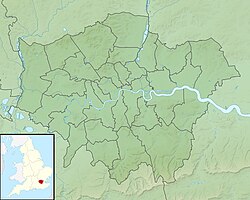History
In the 17th century, Highgate was a hamlet to the north of London situated in the midst of the extensive Middlesex estate of the Bishops of London. Nos. 1–6, The Grove, Highgate were built in around 1688 by a City of London merchant, William Blake. Constructed in the gardens of a large mansion called Dorchester House, the speculative development was intended by Blake to fund a charity school he had established in the main building. [3]
In 1816, Samuel Taylor Coleridge, moved to the Highgate home of his doctor, James Gillman, seeking treatment for his addiction to opium. In 1823 the Gillmans moved to No. 3, The Grove, installing Coleridge in a suite of rooms on the top floor. [a] [5] He remained there until his death in 1834; [6] writing, revising and republishing earlier works such as Kubla Khan , receiving visitors and becoming lauded as "the Sage of Highgate". [7]
In 1931 the house was bought by J. B. Priestley, [8] using the profits from his novels, which had brought literary and worldly success since the publication of The Good Companions in 1929. [9] He engaged Seely & Paget to reconstruct the house [10] and the landscape architects Mawson's to redesign the garden. [11]
In the 21st century, No.3 was home to the model, Kate Moss. [12] Moss sold the house in 2022. [13] [14]
This page is based on this
Wikipedia article Text is available under the
CC BY-SA 4.0 license; additional terms may apply.
Images, videos and audio are available under their respective licenses.

